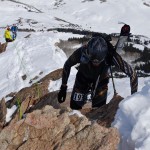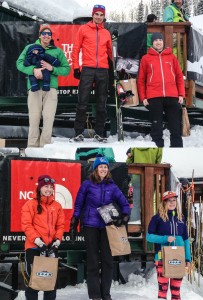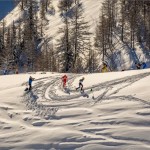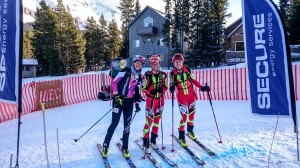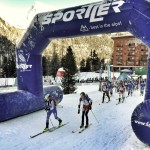
In this article, we are going to share some tips and our general observations to help you navigate the foreign waters. They are mostly based on Eric’s experience from racing most of the 2014/15 World Cup circuit while staying in Chamonix for few months, with Stano adding a couple of useful bits as well (after all he grew up in Europe).
Registering for races
Make sure to research sign-up opening and deadline at least 5-6 months ahead of the event as many races (specifically Pierra Menta, Mezzalama and Patrouille de Glaciers) tend to sell out in a matter of few weeks. In general, the registration fees (calculated per day) are comparable to North American events but obviously vary from race to race, and the value of services depends on the organizers but usually it’s pretty high. The current system uses a central registrations system through the Grande Course website which should be the first stop to investigate.
Make sure you have all your information sorted before reg including your National and ISMF license.
Another thing to keep in mind, when signing up, are potential requirements which don’t exist in North America. From special gear (rope, ice axe, etc) to doctor’s note proving you are healthy to race, make sure to study each race’s rules. Doctor’s notes are much easier to get in North America ahead of time than at the last minute in a foreign country. The French Alpine Federation FFME has a form that can be downloaded and filled out.
» Here’s the 2017 Skimo World Cup calendar
Cities to fly into for popular race locations
Given the travel distances to most European races and convenient flight connections from US and Canada we believe these are some of the best cities to fly into:
Geneva, Switzerland:
– very central location with Western Europe
– 1.5h to Chamonix
– 2h to Pierra Menta location
Milan, Italy:
– still quite central location
– 3-4h to 2017 World Champ venues
– 3-4h to most other races
Turin, Italy:
– more difficult with connections but it’s close to many cool races in France and Italy
Zurich and Bern, Switzerland:
– still in the center of things
Barcelona, Spain (Catalonia):
– close to Andorra and Pyrenees
– many cool races within 3-4h, including some 2017 World Cups
– great city to hang out in
Paris, France and Rome, Italy:
– a bit further from the mountains but easy to get connections to
– sightseeing at its best
Below is a Google map with the above cities and some most important/popular races. If you don’t see it then click here to display it on Google Maps.

Transportation – Cars and Trains/Shuttles
For standard ski touring and climbing trips, depending on trains and shuttles is fine. For travelling to races a car is necessary as most are at out-of-the-way locations.
Many car rental companies require a deposit for twice the rental price of the car be put on your card so be sure you have enough of a limit to allow this. Also, most rental cars will have standard transmission unless you pay significantly extra for an automatic. There is nothing like learning to drive a stick in a rental car parking lot in a small town in France 🙂
Also, it is important to be explicit that you require winter tires as driving to some of the ski areas can be treacherous – tiny roads, lots of snow, steep hills. Tire chains can be purchased relatively cheap so better just to buy them rather than rent from the car company. Even if it feels like summer in the valley in which you rent, it may be VERY wintery up at the race venue!
Be prepared as tolls on major freeways in France, Italy, and elsewhere can be significant – it is definitely best to carpool if possible. If you are driving in Switzerland, Germany and other countries you will require an annual or multi-month toll pass sticker (buy it at any bigger gas station).
Places are closer than they are in North America but still require some planning and travel but it’s worth it. One of Eric’s favourite races of his “Euro” season was a last second decision to go to Poland for a teams race. Chamonix to Poland is 1500km (1000 miles) of driving!

Housing and Accommodation
Staying long-term can be tricky if you don’t have a connection with a place to stay. The best chance to find an apartment is if you have a friend who can help.
When travelling to races, ask the race organizers where to stay – they usually have designated athletes lodging with board. This tends to be a simpler option if you are unfamiliar with the area and it allows you to focus on your goals.
Hotels can be expensive and in smaller towns and are a little different than what we expect from North American hotels – usually they are smaller and run fairly minimally, you won’t find a Holiday Inn at Transcavello.

Equipment
If you are going to Europe specifically to race, just bring skinny skis. Most of the time I was on-piste or in the high mountains on stable days. I never used my fat skis once in the four months I was in Europe – that being said, I was there to race and climb, not ski pow or the resorts.
Bring one pair of race skis and one pair of training skis. Mid-winter, the skinny skins were nice but when spring rolled around and things started to melt-freeze regularly, it was key to have wider ones.
Things can get boney so don’t be surprised if you break some equipment. Luckily, most of the equipment manufacturers are located in the Alps so if you break a boot or binding, they are usually pretty helpful. I had very good luck with both Plum and Gignoux promptly fixing broken equipment. The Plum factory in particular was a treat to visit as they refurbished my bindings free of charge on the spot.
Bring sufficient skins (or be prepared to purchase) as a season full of racing will seriously take life out of skins. Ski crampons are critical for spring touring as well.
Crevasses in the alps are serious, much more like the Rockies – actually pretty scary. We carried crevasse rescue equipment most of the time and I was happy to have it. Picking up a short glacier rope when you arrive is relatively cheap (Technique Extreme in Chamonix, View Au Campeur elsewhere in France). For climbing, we usually used a 60m half rope for easier routes and also had a 60m single for harder stuff. This really depends on trip goals (skiing vs. climbing).
I think an axe/tool hybrid like the Petzl Sum’tec is a good option. A light axe is nice for snow but it was handy to have the pick of a tool on the occasion that we encountered a bit of ice. We had tools as well for real climbing and that was worth it.
It’s usually pretty warm in central Europe. I had a down jacket that I used rarely and a thin synthetic puffy that I used ALL the time. A sleeveless shirt to wear under the skin suit was also invaluable in warm weather races.

Power
Check all your appliances and see if you need a power transformer or just a converter. Everything I brought with me required just a basic plug converter except for my boot dryer which I didn’t check because everything else worked fine. I plugged it in and it went into turbo drive and then started smoking… 🙂
Food
Gels, energy food, etc. are expensive in Europe so bring as much as you can from home. Stuff your ski boots with gels. Bring specialty foods (chia, hemp hearts,…) if you eat them as they are harder to a get hold of in many places.
Remember, grocery stores in Europe are smaller and operate in much more limited hours. Most small towns won’t have a superstore type grocery but just a small family run store. There is frequently a lunch/afternooon break when the store is closed and it can be almost impossible to find groceries in a small town on a Sunday. Plan ahead or be prepared to be eating bread and Nutella for dinner 🙂

Training
European resorts are much more tolerant of uphill skiers on-piste than resorts in North America but still rules can be quite variable. Some resorts have specific off-piste access routes while others allow skinning anywhere on-piste at any time. For example, Grand Montets in Chamonix allows you to skin up the ski-out run outside of operating hours and has an off-piste access route for during hours.
In the spring however, the access route was melted out so we skinned up the run. Patrollers were rare but warned us that we were breaking the rules skinning during operating hours but never explicitly asked us to ski down. Verbier on the other hand was a free for all. The best strategy is probably to talk with a local racer or check in at the local touring store to find out the ideal place to train.

Other useful tips
A data plan was super handy – finding hotels and race venues we used GPS and email a ton. It is easy to buy a cheap phone when you arrive and can be nice for in-country calls or emergencies but may not work everywhere. I’ll spend the extra money on a worldwide data plan next time. (Note: even a really good data plan may not work everywhere – ahem – Andorra…)
Wifi is much less reliable. Cafes frequently have wifi but expect to buy something and it’s pretty slow. Finding free, fast wifi to do work-related things was much more difficult than in North America. Uploading batches of photos was nearly impossible. Hotels frequently advertise wifi but only offer it in the lobby (and it is slow). McDonald’s was the most reliable.
Make sure you know the local emergency number. We were the first on scene of a climbing accident and were only able to call the rescue because I had randomly downloaded an app with their number on it to my phone. Without that, we would have had no idea who to call.
I joked that if I ever was to get injured, it should be while I was on this trip because it was the most well insured I’ve ever been in my life. I had travel insurance through my employer, accident/rescue insurance through the American Alpine Club, and because I was racing in Switzerland, I had to purchase rescue service/insurance from REGA. All of this was relatively painless with a bit of research.
Lift tickets work differently and usually better. If you are uploading only once to mid station, it is likely considerably less expensive than a day pass. Downloading only tickets are even less. It’s not like spending $120 just to think about riding a lift at a resort in North America.
What are your tips and observations?
Share your Euro tricks with us in the comments below so we can all have a smoother trip the next time we go 🙂
Thank you!


